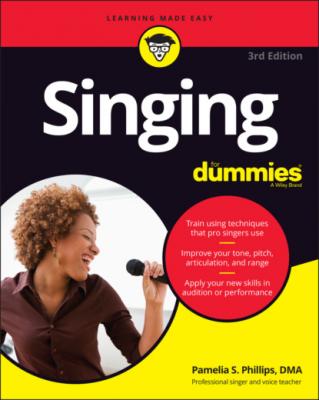ТОП просматриваемых книг сайта:
Singing For Dummies. Pamelia S. Phillips
Читать онлайн.Название Singing For Dummies
Год выпуска 0
isbn 9781119843160
Автор произведения Pamelia S. Phillips
Жанр Музыка, балет
Издательство John Wiley & Sons Limited
To find some inspiration, watch your favorite artist sing and play the piano or guitar. Do they maintain their posture while they’re playing? Some celebrities to watch are Darius Rucker or Justin Timberlake playing the guitar and singing and Lady Gaga or John Legend playing piano and singing.
Chapter 4
Breathing for Singing
IN THIS CHAPTER
How you manage your breath when you sing can drastically change the sound of your singing voice. If you try to hold your breath and sing, it doesn’t work. You also can’t sing a loud phrase without using some air — that is, without exhaling. Most people think of exhaling as involving air, not sound. When you sing, exhaling encompasses both at the same time. Although breathing is natural — you don’t have to think about it — when you sing, you need to train your body to breathe in a certain way so that you breathe efficiently throughout an entire song. You don’t want to run out of breath in the middle of a word. The exercises in this chapter help you master breath control so you can sing through all those long phrases in your favorite songs with ease.
Tackling the Basics of Breathing
When you breathe normally, you automatically make a shallow inhalation and an even exhalation, followed by a pause before it all starts again — you don’t even need to think about it. On the other hand, when you sing, you need to not only inhale quickly and exhale slowly as you sing the phrases of a song, but also maintain proper posture. (See Chapter 3 for more information on posture.) Breathing in this manner gives you the breath control you need to sing efficiently. However, because controlled breathing doesn’t come naturally, you need to train your body to breathe for singing. Keep reading for the breathing basics.
The easiest way to find out how to breathe for singing is simply to feel it. Being able to visualize and feel the proper way to breathe makes the process more natural for you, too.
Inhaling to sing
Singing songs requires getting a full breath quickly — a quick inhalation — because the orchestra can’t wait five minutes for you to find the air. Knowing how your body feels when you inhale helps you quickly get air in your body so you can sing the next phrase. Use the following exercise to explore your own inhalation and get a feel for how your body needs to move when you inhale and exhale.
Pretend that you see someone you’re really happy to see. The surprise breath that you take feels like the air just rushed into your body. You can also pretend that someone told you something shocking.
You probably just took a really quick breath. Quickly filling your lungs with air is the way you want to breathe when singing. As you read this chapter, you discover how to open your body so the breath intake is silent.
Exhaling to sing
Singing requires you to control your exhalation. You want to have a sustained and smooth exhalation so you can sing those demanding high notes and long, slow phrases.
BREATHING LIKE A BELLOWS
Attached to your ribs, your lungs are made of pliable tissue — not muscle. When you inhale, the muscles between the ribs (intercostals) move the ribs up and out as the lungs expand downward. When the intercostal muscles relax back inward, the lungs move back to their normal resting position. Another muscle that moves when you breathe is your diaphragm, a dome-shaped muscle located underneath your lungs and attached to the ribs and the spine. Your diaphragm is actually attached to the rib cage in the front of your body and the ribs and spine in the back, and it doesn’t descend below your ribs. When you inhale, the diaphragm flexes downward and moves back upward as you exhale. If the diaphragm flexes downward as you inhale, the organs below your diaphragm (such as the liver and your stomach) have to move out of the way. The organs move down and out, which is why your abdomen moves out as you inhale. As you exhale, the organs gradually move back to their normal resting positions.
Breathing can be confusing for a singer who’s just starting out, because you have to pay attention to so many things at one time. Different people who know something about singing also may tell you about yet another breathing method to use for singing. One friend may say that their teacher wants them to leave the muscles out — sides, ribs, back — and distended as they sing or exhale; another friend may tell you that the abdominal muscles must move in when you exhale. Who do you believe? Both of them.
Being an “innie” or an “outie” doesn’t refer to just your belly button — it also refers to how you breathe. Both methods are valid; you just need to understand how breath works in your body. Here’s more info about each:
The innie method focuses on moving the ribs and abdomen in gradually during exhalation. If you’re exploring breathing for the first time, start with these exercises.
The outie method requires the singer to focus on keeping the ribs or abdomen out during exhalation. For many singers, the outie method is helpful because beginners have a hard time preventing the

